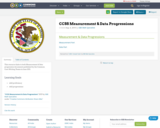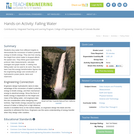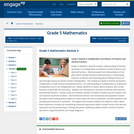
This resource links to both Measurement & Data progression documents published by the Common Core Writing Teams in June 2011.
- Material Type:
- Assessment
- Homework/Assignment
- Teaching/Learning Strategy
- Date Added:
- 05/09/2013

This resource links to both Measurement & Data progression documents published by the Common Core Writing Teams in June 2011.

Students drop water from different heights to demonstrate the conversion of water's potential energy to kinetic energy. They see how varying the height from which water is dropped affects the splash size. They follow good experiment protocol, take measurements, calculate averages and graph results. In seeing how falling water can be used to do work, they also learn how this energy transformation figures into the engineering design and construction of hydroelectric power plants, dams and reservoirs.

The Fifth Grade Elementary Framework for Science and Integrated Subjects,Earth and Space: Patterns in the Sky, uses the phenomena of perceived sun and moon movements that seem to move around the Earth to explore stars, Earth orbit and rotation and moon orbit around Earth. It is part of Elementary Framework for Science and Integrated Subjects project, a statewide Clime Time collaboration among ESD 123, ESD 105, North Central ESD, and the Office of Superintendent of Public Instruction. Development of the resources is in response to a need for research- based science lessons for elementary teachers that are integrated with English language arts, mathematics and other subjects such as social studies. The template for Elementary Science and Integrated Subjects can serve as an organized, coherent and research-based roadmap for teachers in the development of their own NGSS aligned science lessons. Lessons can also be useful for classrooms that have no adopted curriculum as well as to serve as enhancements for current science curriculum. The EFSIS project brings together grade level teams of teachers to develop lessons or suites of lessons that are 1) pnenomena based, focused on grade level Performance Expectations, and 2) leverage ELA and Mathematics Washington State Learning Standards.

Grade 5s Module 4 extends student understanding of fraction operations to multiplication and division of both fractions and decimal fractions. Work proceeds from interpretation of line plots which include fractional measurements to interpreting fractions as division and reasoning about finding fractions of sets through fraction by whole number multiplication. The module proceeds to fraction by fraction multiplication in both fraction and decimal forms. An understanding of multiplication as scaling and multiplication by n/n as multiplication by 1 allows students to reason about products and convert fractions to decimals and vice versa. Students are introduced to the work of division with fractions and decimal fractions. Division cases are limited to division of whole numbers by unit fractions and unit fractions by whole numbers. Decimal fraction divisors are introduced and equivalent fraction and place value thinking allow student to reason about the size of quotients, calculate quotients and sensibly place decimals in quotients. Throughout the module students are asked to reason about these important concepts by interpreting numerical expressions which include fraction and decimal operations and by persevering in solving real-world, multistep problems which include all fraction operations supported by the use of tape diagrams.
Find the rest of the EngageNY Mathematics resources at https://archive.org/details/engageny-mathematics.

(Nota: Esta es una traducción de un recurso educativo abierto creado por el Departamento de Educación del Estado de Nueva York (NYSED) como parte del proyecto "EngageNY" en 2013. Aunque el recurso real fue traducido por personas, la siguiente descripción se tradujo del inglés original usando Google Translate para ayudar a los usuarios potenciales a decidir si se adapta a sus necesidades y puede contener errores gramaticales o lingüísticos. La descripción original en inglés también se proporciona a continuación.)
Módulo 4 de grado 5 extiende la comprensión del estudiante de las operaciones de fracción a la multiplicación y la división de fracciones y fracciones decimales. El trabajo procede de la interpretación de los gráficos de línea que incluyen mediciones fraccionales para interpretar las fracciones como división y razonamiento sobre la búsqueda de fracciones de conjuntos a través de la fracción por multiplicación de números enteros. El módulo procede a la fracción por multiplicación de fracción en formas de fracción y decimal. Una comprensión de la multiplicación como escala y multiplicación por N/N como multiplicación por 1 permite a los estudiantes razonar sobre productos y convertir fracciones en decimales y viceversa. Los estudiantes son presentados al trabajo de división con fracciones y fracciones decimales. Los casos de división se limitan a la división de números enteros por fracciones unitarias y fracciones unitarias por números enteros. Se introducen divisores de fracción decimal y la fracción equivalente y el pensamiento del valor del lugar permiten al alumno razonar sobre el tamaño de los cocientes, calcular los cocientes y colocar decimales con sensatez en los cocientes. A lo largo del módulo, se les pide a los estudiantes que razonen sobre estos conceptos importantes interpretando expresiones numéricas que incluyen operaciones de fracción y decimales y perseverar en la resolución de problemas de varios pasos en el mundo real que incluyen todas las operaciones de fracción compatibles con el uso de diagramas de cintas.
Encuentre el resto de los recursos matemáticos de Engageny en https://archive.org/details/engageny-mathematics.
English Description:
Grade 5s Module 4 extends student understanding of fraction operations to multiplication and division of both fractions and decimal fractions. Work proceeds from interpretation of line plots which include fractional measurements to interpreting fractions as division and reasoning about finding fractions of sets through fraction by whole number multiplication. The module proceeds to fraction by fraction multiplication in both fraction and decimal forms. An understanding of multiplication as scaling and multiplication by n/n as multiplication by 1 allows students to reason about products and convert fractions to decimals and vice versa. Students are introduced to the work of division with fractions and decimal fractions. Division cases are limited to division of whole numbers by unit fractions and unit fractions by whole numbers. Decimal fraction divisors are introduced and equivalent fraction and place value thinking allow student to reason about the size of quotients, calculate quotients and sensibly place decimals in quotients. Throughout the module students are asked to reason about these important concepts by interpreting numerical expressions which include fraction and decimal operations and by persevering in solving real-world, multistep problems which include all fraction operations supported by the use of tape diagrams.
Find the rest of the EngageNY Mathematics resources at https://archive.org/details/engageny-mathematics.
![OREGON MATH STANDARDS (2021): [5.DR]](https://img.oercommons.org/160x134/oercommons/media/courseware/lesson/image/13138_ODE_Math_Logo_2018-H_color_BvjqVNy.png)
The intent of clarifying statements is to provide additional guidance for educators to communicate the intent of the standard to support the future development of curricular resources and assessments aligned to the 2021 math standards. Clarifying statements can be in the form of succinct sentences or paragraphs that attend to one of four types of clarifications: (1) Student Experiences; (2) Examples; (3) Boundaries; and (4) Connection to Math Practices.

Popcorn pops due to the moisture in the kernel that explodes when heated. In this lesson students will compare kernels soaked in water before popping with dry kernels to see whether it makes a difference in the number of unpopped kernels.